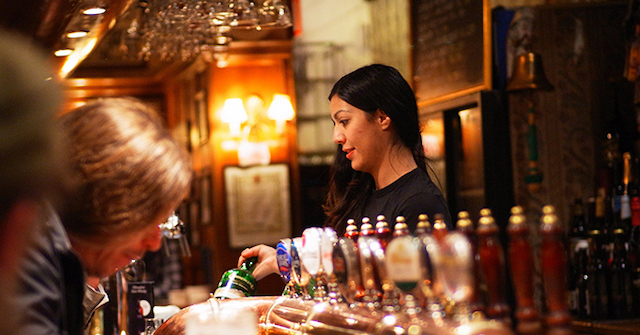As a bartender, you’re probably already looking for the early signs of a fight, reading the room to see which patrons have had enough. It might not be too much a stretch to start keeping your eyes open for the earmarks of sexual assault, or an interaction based on a guest or co-worker’s vulnerable racial, sexual or religious identity. While it might be second nature for you to step in and de-escalate a fight, it might not be intuitive to handle a less straightforward situation.
For Angie Fetherston, CEO of Drink Company in Washington D.C., that’s where someone like Safe Bars comes in. “What they’re doing is specific skills,” she says. “That’s why that training is so important. It’s not just like: ‘this is sexual assault. Here’s a cheesy seventies video.’ It’s like: ‘let’s role-play. If this happens, you do this. These are your strategies.’ It’s recipes, not philosophy.”
Safe Bars is a partnership between Defend Yourself, which teaches skills for stopping harassment and assault, and Collective Action For Safe Spaces, which works to end harassment in the street and in other public spaces.
“Bar, club and restaurant staff are perfectly positioned to intervene in unwanted sexual aggression,” says Lauren Taylor, co-director of Safe Bars. “Studies have shown that the environment and the culture around an aggressor can make a difference in their behavior.”
Although the current Safe Bars training focuses on preventing sexual assault and gender-based violence, it’s much more intersectional than that. “We talk about many different identities, or perceived identities, that people may be targeted for. Not just being female, but also LGBTQ or gender non-conforming, being a person of color, a person with a disability, a person of a non-dominant religion,” says Taylor. “We talk about how the more marginalized identities you have, the more likely you are to be targeted, because people target people who they perceive to be vulnerable. For example, trans women of color experience some of the highest rates of violence of anybody in the country. We also ask the participants to examine how their real or perceived identities shape their understanding of harassment.”
Fetherston has a three tiered approach to training on these topics. Everything starts with open communication. “You can encourage conversation. You can encourage people to ask questions about how to deal with these situations or ask questions about whether something is sensitive,” she says. “Every day we have a lineup before service where we bring up these issues. It’s not just like: ‘oh, there’s going to be a party of seven,’ it’s like: ‘okay, what if this situation were going to happen?’ or ‘how would you handle this?’ or ‘what do you think about what’s happening in the world?’ We leave them a little bit of a safe space over some food to be able to talk about these things.”
The second tier is formal training. “When you go behind the bar everything is a mile a minute so for them to be able to have preprogrammed responses is huge, that’s where the formal training helps,” says Fetherston. “They’re all good people and they want to help. No one wants anybody to get sexually assaulted, but when they see a behavior, if they have these preprogrammed responses and they’re able to act in one of a few ways, they’re more likely to.”
Tier three goes beyond the bar and into the community. “We care about our employees. We want them to be good people, so anything that we can give them to send them into the world looking out for one another or being able to take care of themselves, it’s huge for us.”
“I think that most people who work at bars, clubs and restaurants already have a good deal of skill because their job is already to make sure that their patrons are having a good time,” says Taylor. “I think when you’re in hospitality, that’s the air you breathe. Those same skills, in large part, may be needed more often or in more extreme situations, but I don’t think that they are radically different skills. I think a lot of people who work in bars already have a good feel for intervention and for de-escalation, so even if they don’t have the good fortune to be trained by somebody like us, I would really encourage people to examine what they’ve already got and build on that.”
Taylor recommends that bars consider organizing skill swaps internally and possibly with others in the local hospitality community. “It may be so routine that they don’t even know that they’re doing it. It may take sitting down with your coworkers and checking out what your resources are, doing a little self-examination, then talking through some situations that you’ve either seen or that you’re afraid of that might happen.”
As general manager of The Partisan in Washington D.C., Sherette Williams is no stranger to the front lines. While she’s a fan of Safe Bars and other similar trainings, for her, nothing beats experience in the trenches. “It’s one of those things where you’ve got to learn by what happens. No two situations are the same,” she says. “It’s about realistically seeing the damage that’s being caused. You have to make very quick decisions. Something to keep in mind is that the people who are offended are a larger mass. Speaking from a business standpoint, whoever you are ‘rescuing’ or being the confronter for in that situation is going to be very pleased with you. That’s something that will spread word of mouth. Whoever is offending, at the end of the day, it’s probably not somebody you really want in your place anyway. I think if you don’t tolerate that negativity the rewards that come from it are just so beneficial.”
“Bars are where communities happen, and if people feel invited and welcome you’re going to make money, and they’re going to come back. They want places where they feel good,” says Fetherston. “Investing what is really not very much money in this training to create this environment for people is big.”
Guests aren’t the only ones who might need a little intervention from time to time. As a manager, Williams is intentional about keeping conversation lines open with her staff and making it clear that she doesn’t want them to be in situations that make them uncomfortable. “Guests are a priority for us, but from my standpoint, our staff is the number one priority,” she says. “Because if they’re happy, then guests are happy.”
Taylor points out that bar staff might need to be prepared to intervene within the team as well. “I think the collegiality and the fact that in a bar usually people talk about their co-workers as family is a huge plus,” she says. “[But] sometimes people are harassed and attacked by their co-workers, certainly sexually and also racially, it has come up in our trainings. It’s not always an entirely safe environment and people don’t always see everybody as their family. That’s something that also needs to be dealt with.”
For Fetherston, trainings like this go far beyond the bottom line, they are imperative. “To me it’s moral,” says Fetherston. “Fifty percent of sexual assaults have some sort of alcohol as a weapon, or as a component. If you could stop one rape, or sexual assault, or unfortunate situation, how much is that worth? I mean, to me it’s enormous.”





